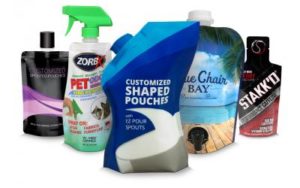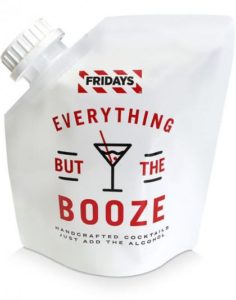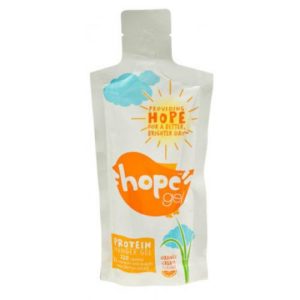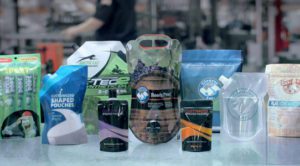 Whether you’re launching a new product or trying to invigorate an established product line, choosing stand-up pouches for your packaging can be a game changer. Some of the various benefits drawing brands to pouches include:
Whether you’re launching a new product or trying to invigorate an established product line, choosing stand-up pouches for your packaging can be a game changer. Some of the various benefits drawing brands to pouches include:
- Pouches fit consumer lifestyle trends; on-the-go consumers find lightweight pouches easy to carry, reseal, and store.
- Many pouches make it easier for consumers to dispense and use the product inside, and allow for complete evacuation of the product (as opposed to rigid packaging).
- Pouches provide ample billboard space for on-shelf brand-building.
- Flexibles offer a contemporary look and work well with design-forward graphic treatments.
- Many consumers perceive stand-up pouches as a signifier of a quality, premium product.
- Millennials are “flexible packaging natives” who grew up seeing juice in pouches, and they are more accepting of pouches than any preceding generation.
- New features and spouts provide opportunities for differentiation.
- The convenient benefits of stand-up pouches add value for consumers, ultimately driving sales of your products.
Choosing between premade pouches and form-fill-seal pouches
Once a brand is open to the possibilities of stand-up pouches, there are many decisions to be made, one of which is determining whether to choose premade pouches (also known as preformed pouches) or to explore form-fill-seal (f/f/s) pouches. In a nutshell, premade pouches are fully-formed and fillable pouches manufactured by flexible packaging converters, while f/f/s pouches involve purchasing flexible packaging in the form of rollstock and forming the rollstock into pouches on f/f/s pouching machinery.
 Choosing premade pouches is a natural choice for many brands because typically, cost of entry is significantly lower, product scrap waste is lower, more pouch features are available, and you won’t be limited to only a handful of pouch shapes or sizes. Also, premade pouches are manufactured by experts in flexible packaging—many of whom are continually investing in new materials and pouching technology—and they can guide you through the process from concept to commercialization. When choosing f/f/s stand-up pouches, volumes typically need to be very high in order to justify the cost of the machinery, and the time required to get a machine up and running (along with the inevitable learning curve of becoming your own in-house pouching operation) adds up quickly.
Choosing premade pouches is a natural choice for many brands because typically, cost of entry is significantly lower, product scrap waste is lower, more pouch features are available, and you won’t be limited to only a handful of pouch shapes or sizes. Also, premade pouches are manufactured by experts in flexible packaging—many of whom are continually investing in new materials and pouching technology—and they can guide you through the process from concept to commercialization. When choosing f/f/s stand-up pouches, volumes typically need to be very high in order to justify the cost of the machinery, and the time required to get a machine up and running (along with the inevitable learning curve of becoming your own in-house pouching operation) adds up quickly.
Which type of premade pouch supplier should I choose?
The quantity of premade pouches you need is one of the biggest factors that will determine which type of premade pouch supplier is ideal for you.
As a general rule of thumb, if you need fewer than 25,000 pouches, a “narrow web converter” or “narrow web printer” is a good place to start, because this converter’s equipment is well-equipped for these volumes. Not all narrow web printers work with flexible packaging (for instance, some specialize in labels), but these days, many narrow web converters have made the leap to flexible packaging. Narrow web converters typically buy unprinted flexible packaging laminations from a third party, and then print on these materials using digital or flexographic printing. To form the printed lamination into premade pouches, a small number of narrow web flexible packaging converters have their own in-house pouching equipment, but the majority outsource this step.
If you need more than 25,000 premade pouches, a “wide web converter” is your best bet. Wide web converters will manufacture your flexible packaging materials using extrusion or adhesive lamination (or sometimes a combination of the two), and they are well-equipped to custom-engineer your flexible packaging laminations specifically for your product’s unique formulation and required barrier properties. Your flexible packaging laminations can also be customized to meet various requirements such as:
- consumer needs
- filling machine and/or copacker requirements
- distribution methods
- desired shelf life
- regulatory requirements
 Even the climate your product is used in can play a factor in how your flexible packaging laminations are engineered. For example, Glenroy (a wide web converter that specializes in flexible packaging and premade pouches) was tasked with engineering a flexible packaging lamination for a nutritional gel named HopeGel. The gel was designed to aid severely malnourished children in Haiti. The packaging had to meet very stringent requirements because the gel was going to be distributed and consumed in a humid area with intense sun exposure, requiring an extremely high barrier against light, oxygen, and moisture. Light could cause the gel to coagulate, and oxygen could diminish the nutritional value of the product. When engineering this flexible packaging lamination, Glenroy’s packaging engineers factored in these numerous requirements along with variables such as tear propagation, burst strength, stiffness, and sealing requirements. They were able to devise a five-layer flexible packaging structure that provided the protection HopeGel required in order to get the uncompromised product to malnourished children in Haiti. Learn more about the amazing story behind HopeGel here: https://www.glenroy.com/about/success-stories/hopegel
Even the climate your product is used in can play a factor in how your flexible packaging laminations are engineered. For example, Glenroy (a wide web converter that specializes in flexible packaging and premade pouches) was tasked with engineering a flexible packaging lamination for a nutritional gel named HopeGel. The gel was designed to aid severely malnourished children in Haiti. The packaging had to meet very stringent requirements because the gel was going to be distributed and consumed in a humid area with intense sun exposure, requiring an extremely high barrier against light, oxygen, and moisture. Light could cause the gel to coagulate, and oxygen could diminish the nutritional value of the product. When engineering this flexible packaging lamination, Glenroy’s packaging engineers factored in these numerous requirements along with variables such as tear propagation, burst strength, stiffness, and sealing requirements. They were able to devise a five-layer flexible packaging structure that provided the protection HopeGel required in order to get the uncompromised product to malnourished children in Haiti. Learn more about the amazing story behind HopeGel here: https://www.glenroy.com/about/success-stories/hopegel
Wide web converters usually have a team of packaging and processing engineers onsite capable of providing a full range of services that may include:
- Pouch engineering, sizing, and prototyping – determining pouch dimensions and configurations based on the product type and volume, and developing digital and physical prototypes.
- Reverse engineering – also referred to as “material breakdown testing”, this can assist with the process of selecting a flexible packaging structure by identifying materials used in existing flexible packaging applications.
- Product/package compatibility testing – testing how the key ingredients in your product interact with various flexible packaging materials. This will determine the flexible packaging materials that are resistant to chemical degradation or physical change during interaction with the product inside.
- Compression testing – subjecting pouches to various air pressure forces for varying lengths of time.
- Interlayer adhesion testing – verifying that the layers of the packaging film structure meet the required bond level for each application.
- Seal testing – testing for fusion seals that bond the plastics in the flexible packaging material together on a molecular level, the same way that the plastics in a rigid container are formed.
- Puncture resistance testing – using ASTM testing standards, analyzing how much pressure is required to puncture the flexible packaging material.
- Pour testing – testing for a clean and controlled pour.
- Tensile testing – sealing the flexible packaging film to itself and testing the amount of force required for the seal to break.
- Vacuum testing – submitting pouches to the equivalent of 1 atmosphere of external vacuum pressure to ensure that they are hermetically sealed.
- Burst testing – exposing pouches to internal pressure until they burst to verify the strength of the seals.
- Drop testing – testing the height from which the pouch can be dropped without failing.
Some wide web converters may charge fees for these services, but Glenroy provides these services gratis for customers.
It’s not uncommon for wide web converters to have some pouch converting equipment in-house, but many have to outsource this step of the premade pouch manufacturing process, especially if spouting is involved.
Pouch Converting

